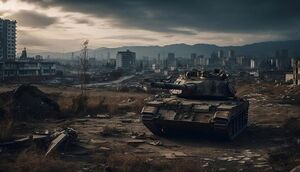War of the Leaves
This article is incomplete because it is pending further input from participants, or it is a work-in-progress by one author. Please comment on this article's talk page to share your input, comments and questions. Note: To contribute to this article, you may need to seek help from the author(s) of this page. |
| The War of the Leaves | |||||||
|---|---|---|---|---|---|---|---|
| |||||||
| Belligerents | |||||||
| Commanders and leaders | |||||||
|
| ||||||
The War of the Leaves (2000-2004 CE), also known as the First Blood War, was a conflict fought between the Hakulic government of Seclya and the current government of Seclya, the Saahein Sovereignty. Fighting began in early 2000 following centuries of oppressive rule over the Saahein and Lashein Elven populations of Seclya and their near-complete slavery experienced under the iron fist of Hakul.
The war itself was initially one of uprising against what was at the time, deemed the lawful government of the country by most nations abroad. The stalwart leadership of Ruven Rothilion throughout the initial course of the uprising culminated in his convincing Amador to intervene on the behalf of the uprising by offering at first, financial and material aid, followed by a declaration of war by the Amadorians and the full-borne invasion of Seclya through their shared borders.
The war concluded in late 2004 following several key military victories, including the Battle of Haanathemar and the Battle at Enas Shaereth off the coast of Amador. The ousting of the Hakulic government resulted in the reformation of Seclya into a monarchial system, installing Ruven Rothilion as Ostrax of Seclya, while Issarel Ermys, an Amadorian noble, as Miax of Seclya, creating the House of Rothilion-Ermys.
The aftermath of the war saw Amador and Seclya establish formal relations through the Ilymmelle Accords, a series of negotiations held in Ilymmelle aimed at detailing out a plan to reconstruct and defend the newly formed government and its populace from future attacks. As a result, both nations have become particularly intertwined politically, culturally, and economically.
The Hakulic remnants were forced to abandon their ancestral homelands, ultimately settling in Scailand in the Badlands Frontier, a frozen land with little in the way of luxuries. Seclyai-Amadorian-led have continuously monitored the remnants in the decades following the end of the war, ever vigilant of their encroaching threat.
Background
Saaehin Oppression under Hakulic Regime
Prelude
Progression and Conflict
Initial Outbreak of War
Early Hakulic Victories
Amadorian Intervention and Invasion
Amador would successfully intervene in the conflict following the diplomatic visit by Ruven Rothilion to the Imperium in an attempt to formulate support from the Alfar nation. Following weeks of negotiations, Amador would officially enter into the conflict on September 18, 2000, commanding its air forces to began conducting aerial bombardments of Hakulic military infrastructure and performing aerial reconnaissance. Amador would officially begin putting boots on the ground in mid-October, with the arrival of the IX Legion.
The initial phases of Amador's involvement were largely through the air and through economic and material aid. The arrival of Amador's legions would enable Saahein forces a chance to recover and reinforce themselves. Initially outnumbered by Hakulic forces, the arrival of Amador's military halted Hakulic offensives, forcing a stalemate that would ultimately last throughout much of 2001 as Amador deployed its forces. During the stalate, Amador made use of this time to also reinforce its Saahein allies, conduct various training course, and gather information of the Hakul.
Late 2001 saw the fruits of their labors flourish, with Saahein-led forces in conjunction with Amaorian allies beginning their full-scale invasion of Seclya, began their winter offensive, beginning a slow and agonizing offensive that would last the new 30 months.
Battle of Haanathemar
Aftermath
Banishment of Hakul
Establishment of a New Kingdom
Casualties
Amador
Amador's intervention and subsequent invasion would prove costly for the Imperium, with the war proving to be amongst the bloodiest it had fought in centuries. Tens of millions would be wounded, including civilian's. Of the 24,398,779 casualties confirmed, 3,928,385 would be confirmed dead through combat, while 377,284 would die as prisoners of war in Hakulic camps.
